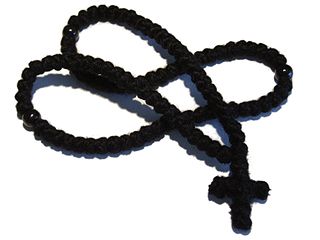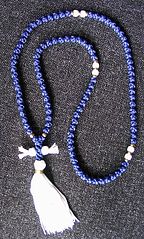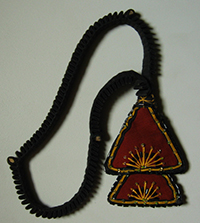Orthodox Prayer Ropes

By Daniel Tibi (Dti) | daniel-tibi.de [Public domain], via Wikimedia Commons
Komboskini or Chotki
Eastern Orthodox Christians use knotted ropes rather than strings of beads for counting their prayers. The prayers ropes (called komboskini in Greek and chotki in Russian) have 100, 50, or 33 knots, and the 100 knot ropes sometimes have a bead every 10 or 25 knots to aid in keeping count. There is usually a cross made of knots where the loop begins and ends, and tassels at the end of the cross are common in longer ropes.
The use of prayer ropes is believed to have begun with St. Pachomius, an Egyptian monk, in the 4th century. He invented the ropes to enable illiterate monks to say a consistent number of prayers.
Materials used to make prayer ropes

By Theona (Own work) [Public domain], via Wikimedia Commons
Prayer ropes are traditionally made from wool, to symbolize Christ's flock, though in recent times other fibers, such as hemp or acrylic, are sometimes used. If beads are present, they are usually made of wood, but beads of all kinds have been used. Traditionally, the wool is black, to symbolize mourning for ones sins. The beads are either black, or if colored, red, symbolizing Christ's shed blood.
Usage
Though prayer ropes have mostly been associated with monks and bishops, they are also used by devout lay members. The knots are used to count off repetitions of the Jesus Prayer: "Lord Jesus Christ, Son of God, have mercy on me, a sinner." The rope is not to be worn around the neck or otherwise openly displayed, as this would be considered boasting of one's piety.
Lestovka

By Russianname (Own work) [GFDL, CC-BY-SA-3.0 or CC-BY-2.5], via Wikimedia Commons
A Russian Orthodox variant of the prayer rope is the lestovka, which is made of leather. The knots are replaced by loops, by looping leather around small twigs. Rather than a cross, the lestovka ends in four triangular flaps, which symbolize the four Gospels. While popular in the Middle Ages, lestovka are rarely used today.